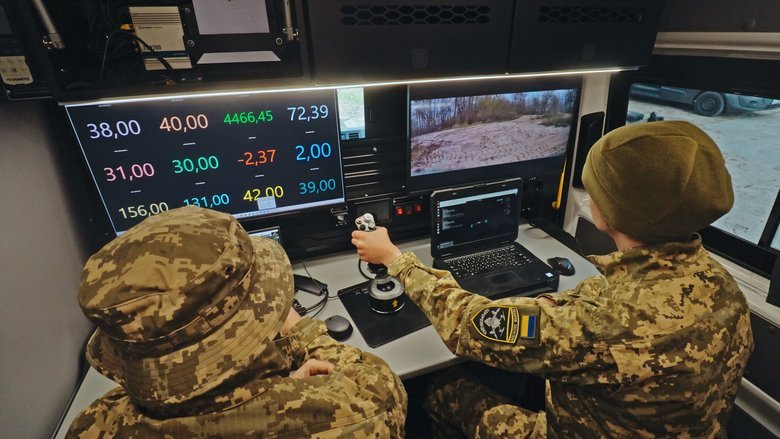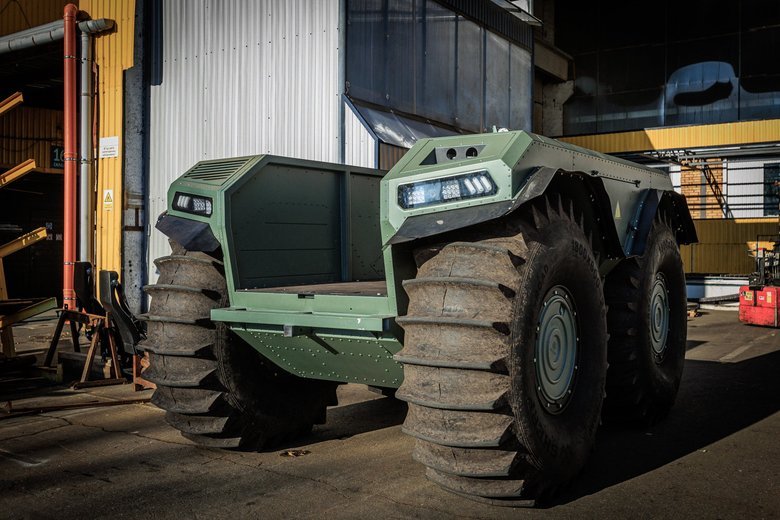UNEX UGV project lead: 70-80% of ground operations will involve UGVs
Drone Industry
Unmanned technologies today cover the air, sea, and land domains. But while UAVs and uncrewed surface vessels (USVs) are widely discussed, with plenty of footage of them in action online, ground systems have largely remained in the shadows. At the same time, the demand for such machines at the front is considerable. They are employed not only for logistics missions but also for minelaying and demining, as well as casualty evacuation. Experts see significant potential in the employment of UGVs (unmanned ground vehicles).
One such system is the UNEX UGV, a Ukrainian-made, remotely operated, electric self-propelled platform. In April 2025, the vehicle was codified and approved for use within Ukraine’s Defense Forces.
As part of its "Drone Industry" project, Censor.NET spoke with Mykola Kozlov, CEO of UNEX UGV, the manufacturer. We discussed employing UGVs (unmanned ground vehicles — ed.) not only on the battlefield but also in civilian life, other countries’ interest in robotic systems, export prospects, and the challenges arms manufacturers in Ukraine are currently facing.
– When people talk about drones, aircraft are what typically come to mind, although ground robotic systems are an equally important part of the technology. Please tell us more about UGVs and how acute the need for them is at the front today
– The war has demonstrated to everyone what drones can do. Aerial platforms have indeed seen the broadest development and use so far. But UGVs are now advancing rapidly. They have a wide range of applications - logistics, minelaying, and casualty evacuation.
Nearly all UGVs on the market today are built around a single mission. We, by contrast, have developed a platform that can integrate and adapt. Its baseline role is logistics; moreover, our vehicle has the highest rated payload capacity, 1.7 tonnes, with nothing comparable on the market.
In addition, the platform can be fitted with virtually any payload—other unmanned systems, launchers, robotic turrets, electronic warfare (EW) systems, and more. In other words, you can field a convoy: one vehicle with EW, another with logistics. Protection is a critical issue for UGVs.
– Do soldiers need additional coordination training to operate these systems? How quickly can operators learn to control the vehicles?
– A UGV can be employed individually, independent of other teammates or units. That said, more complex missions obviously require cooperation. The primary scenario is when an aerial drone relays terrain data and builds a 3D map, and based on those data the UGV operator deploys on the mission.
– Tell us more about your development. What sets it apart from other UGVs? You’ve already mentioned payload capacity. What else?
– Yes, the highest payload capacity. It is also a platform built to integrate with a wide range of other solutions. It’s a fully electric version with an endurance of up to six hours. And it offers unrestricted mobility, there are essentially no barriers for it. The vehicle negotiates obstacles up to one meter (a fallen tree, a collapsed wall, etc.). In addition, our UGV is amphibious. It is one of the few and perhaps the only robotic platform that can carry out a mission on land, then in water, and back on land within a single sortie.
– What problems are you facing today as a manufacturer, and how do you see them being resolved?
– First of all, sourcing components is somewhat challenging. A significant share is imported. The chassis is entirely Ukrainian-made—as is all the metalwork, whereas the electronics are almost entirely imported.
– China?
– No, we have no Chinese elements in the electronics. They are exclusively from European or American vendors.
Another issue is VAT reimbursement. UGVs are sold without value-added tax, but manufacturers have to purchase components with VAT, which ultimately raises the product’s final cost. There is still no clear mechanism for refunding or crediting VAT in such cases.
– But in June, laws were adopted to exempt imported goods for security and defense needs from VAT and import duties. The President even signed them.
– The point is, certain categories of goods are tax-exempt, but the list is very limited. Engines or controllers, for example, but a UGV contains a multitude of parts. That said, the state has indeed been increasingly supportive of defense manufacturers in recent years.
Read more: Defence City: Boost for defence industry or closed club for chosen few?
– How developed is the UGV market today in Ukraine and abroad?
– The UGV market in Ukraine is currently among the most developed, perhaps the most in Europe. There is demand for our vehicle abroad as well, but other countries are only starting to consider the need for such developments. Greece, for example, which has no unmanned ground vehicles at all, is showing strong interest. We are indeed well ahead of other countries, but that was not entirely our choice, the war forced our hand.
– Is there a state order for UGVs? To what extent does it meet the front’s needs and manufacturers’ capacity?
– There is a state order, of course; military units are constantly sending requests. However, at present, it is difficult to satisfy all existing demand, resource-wise, financially, and in terms of production capacity. And I am convinced this applies not only to UGVs but to other areas of defense manufacturing as well.
– There is strong foreign interest in Ukrainian aerial drones today. Decisions on joint production have already been made; for example, an agreement was recently signed with the United Kingdom. Do ground systems attract the same level of interest among partners?
– Interest is at 100%. This spring, we took part in an exhibition in Brno (Czechia), and representatives from various countries, Saudi Arabia, India, and across Europe, showed interest in our vehicle.
You see, it’s not only about war. Our UGV is positioned as a dual-use product. Such a machine is useful not only at the front; it can support construction in remote, hard-to-reach areas and evacuation during emergencies. For example, Lithuania’s Ministry of Emergency Situations has invited us multiple times for joint demonstration trials.
Therefore, to answer your question: the interest is there, but exporting is not yet possible.
– The Russia–Ukraine war has been called "the first drone war." It is obvious that unmanned technologies will only grow within defense doctrines. What is the potential for UGVs here? Can robots replace soldiers on the battlefield?
- Wars should not happen at all. But we find ourselves in circumstances where we have to fight. Nothing is more valuable than life. Modern technologies are advancing at extraordinary speed. The air domain is highly developed, and I’m sure that on land we will see breakthroughs over the next six months. Most likely, 70–80% of ground operations will involve UGVs. In other words, soldiers will be in relative safety, remotely operating the vehicles.




